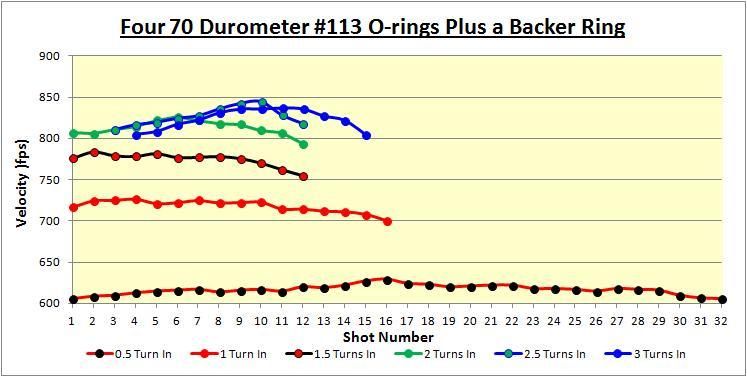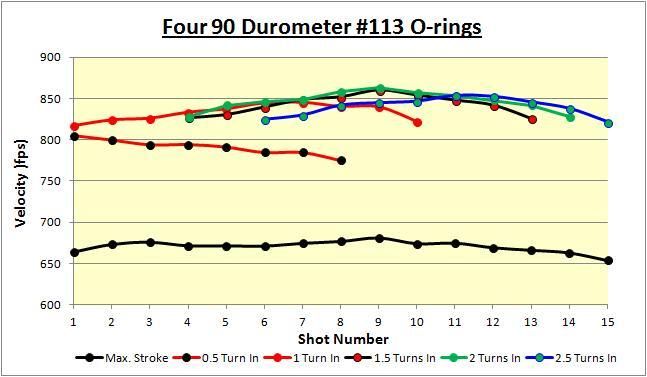I completed the second set of tests, changing the striker setting by only a half turn at a time instead of a full turn.... I also eliminated the settings where I was sure the buffer was not playing a role.... All strings were started at 2000 psi, and the Disco hammer spring was set just shy of coil bind as before.... and only shots within a 4% ES are graphed.... The four 70 Durometer O-rings had a 90D Backer ring under the stack.... and here are the results....
Basically, once the striker is screwed in 2 turns CW or more from the fully CCW position, it is ineffective in altering the shot string to any significant degree.... These results are different for the 3 turns out curve (blue line) which I found in the first test.... My only explanation is that the buffer in that test was moving out of place slightly, and interfering with the hammer in just the right way to skew the results.... That curve was a lower velocity, longer, and flatter, but since I haven't been able to duplicate it in several tries, all I can say is that it was a tease, unfortunately.... The 2 and 3 turn in shot strings are virtually identical to the unbuffered results....
When we explore the striker adjustment range from maximum CCW (minimum lift) to 2 turns in, however, we have some very interesting things happening.... As the velocity drops, the efficiency increases, and the strings get longer.... At 1.5 turn in, the average velocity is 775 fps (at 1.18 FPE/CI), and a 1 turn in, it drops to 718 fps (at 1.36 FPE/CI).... In both cases, a large portion of the first part of the shot string appears to be missing, an indication that the hammer strike is too great for the 2000 psi fill pressure.... For both of those strings, further experimentation is needed.... At 1/2 turn in, the velocity is only 617 fps, but the gun got 32 shots within 4% ES, and the efficiency was 1.65 FPE/CI, very efficient for a 12 FPE gun.... If you remember from the first tests with the 70D buffer, at maximum CCW, the velocity was about 430 fps and the gun did 65 shots at 2.11 FPE/CI between 1650 psi and 1000.... This soft, tall buffer is excellent for drastically reducing the power of the gun and raising the shot count and efficiency.... If that is what you are after, this is something you should definitely consider....
Now to look at the stiffer buffer, consisting of four 90 Durometer O-rings.... Here are the results....
With this stiffer buffer, and without the extra height of the 0.055" thick backer ring, the buffer was basically ineffective once the adjuster was past 1 turn in.... The top group of curves pretty much mirror those of the unbuffered gun at the same adjustments, although for some reason they seem to peak at a slightly higher velocity, although no higher than the unbuffered gun did at maximum.... The efficiencies are similar as well, so IMO no advantage can be found operating in that adjustment range....
Once again, however, when we explore from maximum CCW (minimum lift) over the first part of the striker adjustment, we see more shots at increased efficiency, but at lower velocity.... The shot string at 1/2 turn in (791 fps average) started out with the first shot the fastest, so it definitely needs to be explored with less hammer spring preload.... With the striker at maximum CCW, the velocity averaged 671 fps, and it looked like it too, could benefit from a bit less hammer energy for the 2000 psi fill.... The efficiency of that 15 shot string was 1.30 FPE/CI, and I have a feeling that both can be increased a bit.... However, when you consider that the 1 turn in string with the 70D buffer was higher velocity AND more efficient, I have my doubts if the 90D buffer will show any advantages over the softer one....
There are a couple of general observations I have to make.... When the striker adjustment first starts to have a serious affect on the velocity, it appears that the shot string shifts to the left, ie it peaks at higher pressure.... In an unbuffered gun, that usually indicates too much hammer strike, and that is likely the same case here.... Only adjusting the preload to a lower value will let us find out if there is more shots and efficiency hiding there.... Once the velocity is reduced further, however, the shot string returns to the original peak pressure, and eventually, as the velocity is lowered enough, then the fill pressure must follow, just as in detuning by hammer energy alone.... While the basic idea of reducing lift directly by decreasing the striker engagement with the valve is simple in concept, and very effective.... it still needs that fine tuning of trying various combinations of hammer spring preload and/or fill (and refill) pressure to find the optimum setting....
When time permits, I plan to concentrate on those parts of the envelope where less hammer strike is needed to optimize the results.... In the meantime, there is certainly lots here to chew on and discuss....
Bob








 Reply With Quote
Reply With Quote